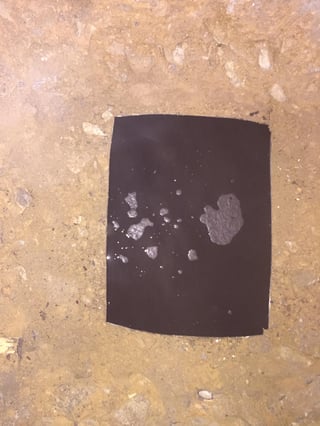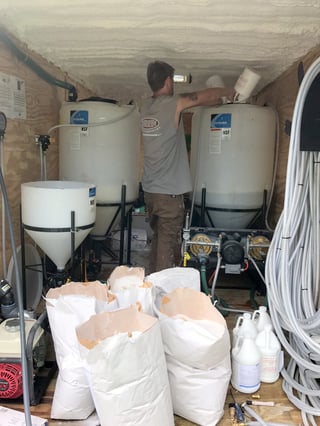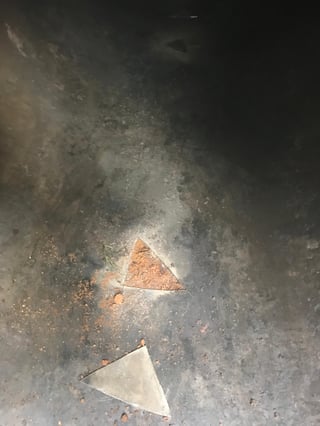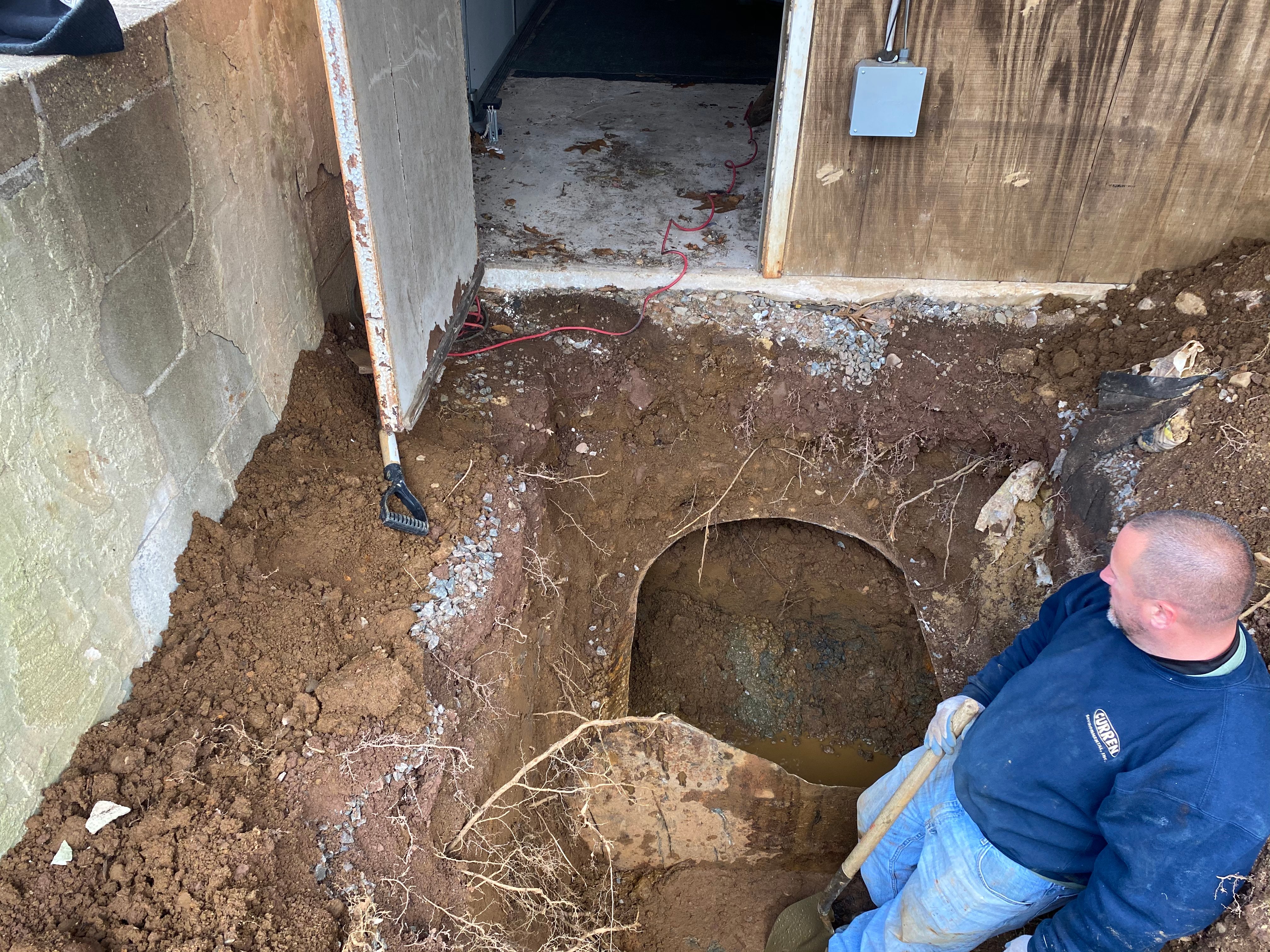Tank Removal vs Tank Abandonment in Place
It seems like everybody who has NEVER dealt with a tank before is an expert, and there are many preconceived notions regarding tank abandonment in place vs tank removal. The biggest misconception is that abandonment is cheaper than removal, and that is wrong 90% of the time. Why?
Tank removal is typically cheaper and the gold standard when it comes to selling a property that has/had oil heat. Let's be clear the word oil tank has a stigma and adds no curb appeal to a property. Best to say the tank is removed with a report to back it up. This is much preferred to saying abandoned tank on property.
Pro Tip:
In all cases where it is feasible, the underground storage tank should be removed.

This photo below is part joke. No, it was ot easy to remove, but Curren removed it. This photois a little more realistic, 1000 Gallon UST, owner concerned about breaking sidewalk, Curren recommended removal in lieu of closing in place.
When is it better to close a tank in Place?
When tanks are located under decks, beneath patios, in basements, crawl spaces and beneath additions. Some tanks were buried without regard to having the tank removed in the future. In certain cases, tank removal is prohibitive (expensive). In these cases, a tank closure in place is the preferred option.
Maybe when the tank is under the house or under the garage floor, like the photo below

Why is tank abandonment not cheaper than removal?
You still need a permit for removal or abandonment & fee. So no difference.
You still need to expose the top of the tank so you can go inside to clean the tank. Yes the only way to clean a tank 100% is to go inside the tank. So real no difference in needing equipment and labor required to excavate. You perhaps have a little more time to remove the tank, but that is nominal.
The photo below is of a tank, that you have to go inside to clean, you can see the oil level on the bottom portion of the tank.

You need soil samples during tank closure to prove the tank did not leak, it adds time and drill bits to sample through a metal tank you are not removing. So soil sampling is the same but for closure in place its more expensive as you have to enter the cleaned tank, and cut coupons (holes) in the bottom of the tank to acquire soil samples, this requires tools, cutting wheels or blades which are consumables and lastly is a confined space task.
Ok so now you have cleaned the tank and obtained samples, now you have to install material to match the void of the tank.
A 500 gallon tank need 2.5 yards of inert material to fill the tank, it's easier to drop that material in a hole where a tank was removed, it's more difficult to try and stuff the material into a vessel. The opening below is a tank that is below a floor in a room, fill material must be placed into the opening and PUSHED TO THE END OF THE TANK (next photo)

The photo below shows fill be placed in the tank that has to be pushed to the far end of the tank.

Why is tank removal better than tank closure in place?
A question to ask yourself: Would you rather be able to tell someone there is no tank on site? Or tell them you have a filled-in place tank in the side yard? That sentence will generate questions for sure.
In addition, abandoned tanks are a play on words. A property owner may have bought a house with a filled-in place tank, or maybe they did it themselves. Guaranteed, this person is not an environmental expert, and 95% of the time, any paperwork available documenting the work is insufficient.
What we see is that people express that they filled their tank in place 15 years ago, and it was inspected and approved by the township, but this is very misleading. The tank, while it may have been filled according to construction code it has nothing to do with environmental codes. The difference is that construction codes are black and white and reflect the codes you follow for construction activities. Environmental codes (If Followed) tell you if you have contamination and an expensive cleanup or not. If you don't want to find that out, people fill their tanks in place.
Remember, the most important question about any tank is if it leaked. So EVERY abandoned tank needs soil testing and a report explaining the test results and why remediation is not necessary, every tank.
It's what we do for every commercial tank (Required by Law), and residential tanks require the same documentation.
The procedures followed to foam fill a tank are as follows:
Step 1: Local Permits
Before any tank closure work can be performed; a permit to abandon the underground tank will be obtained from the local municipality, fire department, health department, or other applicable agency.
Step 2: Excavation
As required by law, Curren will notify the applicable state "ONE CALL SYSTEM" to obtain a utility mark out at the subject site. Once notified, if there are public utilities in the area of excavation, the utilities will mark their lines. All on-site work will proceed after all utilities have been marked.

Step 3: Liquid Disposal
Upon arrival to the site and prior to excavation all pumpable liquid product will be removed from the tank and lines. After removal of the tank pumpable liquids, overburden soils will be excavated to expose the top portion of the tank
Step 4: Tank Cleaning
Uncover the top portion of the tank, cut a hole in the tank. After the tank has been exposed and all the liquids removed, the tank will be purged of petroleum vapors. Continuous atmosphere monitoring of the tank will be performed for flammable vapors and Oxygen content. If no flammable vapors are present and the tank contains sufficient Oxygen, the tank will be entered and cleaned. American Petroleum Institute Publication 2015, "Cleaning Petroleum Storage Tanks," procedures will be followed throughout this phase of the project. Tank cleaning will consist of wiping, squeegeeing, and removing all liquids and sludge from the tank. All liquids and sludge generated as a result of the tank cleaning process will be placed into a vacuum truck and transported off the site under a bill of lading.
exposed and all the liquids removed, the tank will be purged of petroleum vapors. Continuous atmosphere monitoring of the tank will be performed for flammable vapors and Oxygen content. If no flammable vapors are present and the tank contains sufficient Oxygen, the tank will be entered and cleaned. American Petroleum Institute Publication 2015, "Cleaning Petroleum Storage Tanks," procedures will be followed throughout this phase of the project. Tank cleaning will consist of wiping, squeegeeing, and removing all liquids and sludge from the tank. All liquids and sludge generated as a result of the tank cleaning process will be placed into a vacuum truck and transported off the site under a bill of lading.
Call the experts 888-301-1050
Step 5 Soil Sampling
What does everyone want to know about an oil tank> People want to know if they tank leaked. Leaking tanks cost money to cleanup. The way you know a tank did not leak is by obtaining soil sampling. When a tank is being abandoned in place, how do you obtain soil samples from below a steel tank?
You can cut holes or the industry term cut coupons in the bottom of the tank so you can access soils below the tank and obtain your samples. This practice has been followed for over 20 years, the problem is many tank never had the testing performed when the tank was filled in place. These cases dictate that you reverse engineer the prior tank removal by removing all the prior fill installed, you reclean the tank, cut coupons and obtain soil samples.

Step 5: Tank Filling

After the tank has been cleaned and inspected by the local official; the tank can be filled with an inert clean material including sand, concrete slurry or foam. Each has its advantages. Pertaining to foam filling, foam tends to be able to be installed in a tank when access is an issue and when future removal maybe a possibility foam is white in color and is classified as an inert nonflammable material. The foam is mixed on site to the quantity needed to fill the tank void (volume). The photo below shows one of Curren's foam trailers.
The foam is installed utilizing a wand similar to a power washer wand. The hose utilized to transfer the foam can be snaked several hundred feet around corners and down stairs to the tank location.

Foam has superior advantages to reach areas where sand or concrete cannot.
Concrete slurry can also be used, as seen in the following photo:

Step 6: Restoring the excavated area.
In addition to cleaning and filling the tank in place, the outside fill and vent to the tank needs to be sealed so that oil can no longer be delivered to the out of service tank. You must also back fill the area excavated to access the tank. Typically a 4' by 4' area is excavated to safely access the tank top.

Soil Sampling Site Assessment
How do I know the tank abandoned in place didn't leak?
Many people believe that if you leave abandon in the ground you can't obtain soil samples to determine if the tank leaked. This is a false assumption as there are requirements for commercial tanks, which include obtaining soil samples even if a tank is abandoned in place. How this is performed is by cutting holes or as we say in the industry coupons in the bottom of the tank. This coupon clipping allows the soils below the tank to be obtained and placed into laboratory supplied glassware and submitted to a licensed laboratory for analysis. The photo below shows a triangle shaped coupon cut in the bottom of the tank.
Now there are many people who had their tanks filled in place and who did not obtain soil samples, either because they got bad advice from the removal company or they did not want to find a problem, or both. These tanks are a whole separate issue, which you can learn more about by clicking the following link:

In summary, most tanks can be removed for the same cost as abandoning a tank in place. These are sites that have a tank in an accessible location, which is the vast majority of tanks. Now there are situations where there are obstructions that hinder the physical removal of a tank. Maybe you could remove these tanks, but often times the math doesn't work, meaning it is just much more expensive to remove than abandoning the tank in place.
Curren recommends abandoning an underground storage tank in place when the tank is located under a building or would endanger a building structure if removed. It should be noted that some townships and municipalities may say they do not allow abandonment in-place. This is typically not the case as the town would have had to enact a statue or law, which takes time and money. Ask to see the regulation. If abandonment in-place is the only option, then soil sampling beneath the tank is highly recommended.
Pro Tip
What if a tank was abandoned, filled in place under grass in an easy to access area?
If you don't have a report, the tank gets removed. Most likely (based on 10,000's of tanks, people left the tank in place to avoid finding a problem. Don't believe the excuse that they didn't want to make a mess, grass can be replanted, mulch relaid, concrete repaired. Hey have you ever seen an inground pool being built? Yards looks like a major construction site because you need to dig dirt out and bring concrete in. After pool install everything gets redone nice, same thing for a tank removal.
Still have questions? Call Curren Today, we are licensed for tank work in Delaware, New Jersey and Pennsylvania, over 20 years of experience

Some buried oil tanks have had structures built over them, requiring the tank to be closed in place. The photo above is one such property. There is always a workaround.





